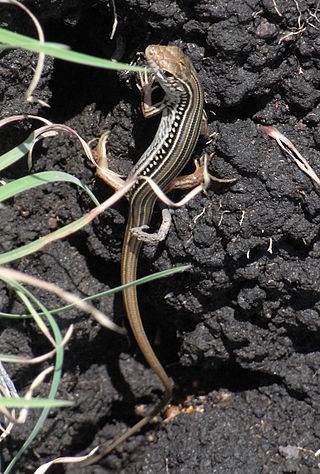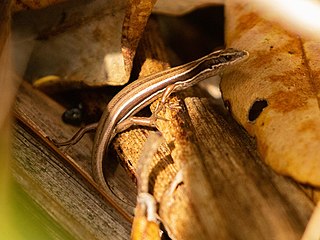
Ctenotus is a genus of skinks, lizards in the family Scincidae. The genus is endemic to Australia. The genus Ctenotus belongs to a clade in the Sphenomorphus group which contains such genera as Anomalopus and the close relatives Eulamprus and Gnypetoscincus.

Mabuya is a genus of long-tailed skinks, lizards in the family Scincidae. The genus is restricted to species from various Caribbean islands. Out of 26 recognized species, six species are only found in Caribbean islands. Species in the genus Mabuya are primarily carnivorous, though many are omnivorous. The genus is viviparous, having a highly evolved placenta that resembles that of eutherian mammals. Formerly, many Old World species were placed here, as Mabuya was a kind of "wastebasket taxon". These Old World species are now placed in the genera Chioninia, Eutropis, and Trachylepis. Under the older classification, the New World species were referred to as "American mabuyas", and as of 2024 include the genera Alinea, Aspronema, Brasiliscincus, Capitellum, Copeoglossum, Maracaiba, Marisora, and Varzea.

Menetia is a genus of skinks, lizards in the family Scincidae. The member species of the genus Menetia are endemic to Australia. They are ground-dwellers and live in open forests and open grasslands.
Scolecoseps is a genus of skinks, lizards in the family Scincidae. The genus is endemic to East Africa.
The great desert skink, also known commonly as Kintore's egernia and by various other names including tjakura in various Aboriginal Australian languages, is a species of skink, a lizard in the family Scincidae. The species is native to the western half of Australia. It is a burrowing lizard and extremely social.

Oligosoma suteri, known commonly as Suter's skink, the black shore skink, the egg-laying skink, and Suter's ground skink, is a species of lizard in the family Scincidae. The species is endemic to New Zealand, found in fragmented populations on the mainland of the Coromandel Peninsula as far south as the Coromandel Peninsula, and on offshore northern islands of New Zealand.

The moko skink is a species of lizard in the family Scincidae (skinks) that is endemic to New Zealand.

Emoia atrocostata, commonly known as the littoral whiptail-skink, mangrove skink, or littoral skink, is a species of lizard in the family Scincidae. It inhabits mangroves, back-beach vegetation and rocky shorelines. It is semi-aquatic and forages in tidal pools.

Anepischetosia maccoyi, also known commonly as the highlands forest-skink, highlands forest skink, Maccoy's elf skink, or McCoy's skink, is a species of lizard in the family Scincidae. It is the only species in the monotypic genus Anepischetosia, and is endemic to Australia.
Slater's desert skink, also known commonly as the Centralian Floodplains desert-skink, Slater's egernia, and Slater's skink, is a species of lizard in the family Scincidae. The species is endemic to Australia. There are two recognized subspecies.
Cophoscincopus durus, the keeled water skink, is a species of lizard in the family Scincidae. It is found in western Africa.
Panaspis togoensis, also known commonly as the Togo lidless skink and simply the Togo skink, is a species of lizard in the subfamily Eugongylinae of the family Scincidae. The species is native to western Africa.

Pseudemoia pagenstecheri, also known commonly as the southern grass tussock skink or the southern tussock grass skink, is a species of lizard in the family Scincidae. The species is endemic to Australia.
Trachylepis buettneri is a species of skink, a lizard in the family Scincidae. The species is native to Central Africa and West Africa.
Ctenotus joanae, also known commonly as the blacksoil ctenotus and the black-soil ctenotus, is a species of lizard in the subfamily Sphenomorphinae of the family Scincidae (skinks). The species is endemic to Australia.

Ctenotus leonhardii, known by the common names Leonhardi's ctenotus, Leonhardi's skink, and the common desert ctenotus, is a species of lizard in the subfamily Sphenomorphinae of the family Scincidae. The species is found in a range of arid and semi-arid regions throughout mainland Australia. Named after German anthropologist Moritz von Leonhardi in 1919, it belongs to the genus Ctenotus, one of the largest genera of lizards in Australia.
Tropidophorus baconi, also known commonly as Bacon's water skink or Bacon's waterside skink, is a species of lizard in the subfamily Sphenomorphinae of the family Scincidae. The species is endemic to Sulawesi (Indonesia).
Tropidophorus beccarii, also known commonly as Beccari's keeled skink and Beccari's water skink, is a species of lizard in the subfamily Lygosominae of the family Scincidae. The species is endemic to the island of Borneo.

Ctenotus helenae, also known commonly as the clay-soil ctenotus, is a species of skink, a lizard in the family Scincidae. The species is endemic to Australia.









